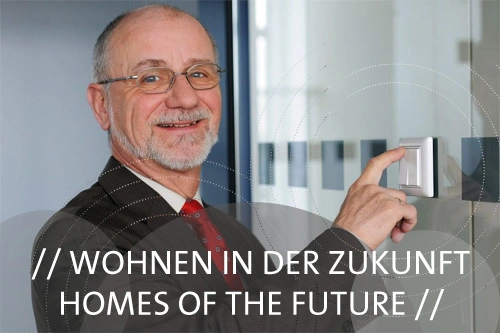Self sufficient components for the homes of the future
GFaI research introduces greater flexibility to facilities
“The utilisation of ambient energy represents a new quality,” replied Professor Alfred Iwainsky when asked about the role of IT technology in the homes of the future. The physics graduate is Chair of GFaI, an association for the promotion of applied information technology in Adlershof. One of the focal points of its research is so called microscale energy harvesting for self sufficient components in homes.
These components are self sufficient, i.e. batteryless and free of connecting cables, which not only introduces greater flexibility to the building’s facilities, explained Iwainsky, but the transmission of digitised wireless signals allows integrated monitoring and control processes in the system without forcing it into a corset of wiring.
Specifically, this innovative technology provides assistance for the residents’ day to day routine. He continued that new offers of technology are important particularly for an ageing population, also in nursing care. The common ground for research and development was provided by the special requirements for the supply of power to distributed and mobile sensors and other ICT components. “With the corresponding microsystems, building facilities can be fitted with self sufficient components that do not need batteries or connections to a power supply,” he explained. The energy is supplied via natural mechanical processes like e.g. pressure from a finger or a solar cell designed for indoor lighting.
To illustrate this, Iwainsky points at a light switch in his office. Unlike the conventional switch built into a wall, his switch is simply stuck to the door. It is not connected to the mains and, when pressed with a finger, sends signals to a power strip that supplies not only the lamp, but a whole series of electric equipment. As a further self sufficient application, he points out small sensors on the windows that register when a sash is opened and immediately instruct an actuator to turn down the heating.
Together with the Charité and four other companies, GFaI is working on the AMENAMIN project (ambient energy and ambient intelligence for senior citizens in need of assistance). Here, the researchers concentrate e.g. on technical solutions for the automated analysis of dementia sufferers’ mental condition, for which e.g. a new kind of self sufficient interactive ball was developed. Other subprojects are developing self sufficient fall sensors, sensors for eliminating bedsores, and fast aid for acute incontinence. Iwainsky explains his vision in homes that can be easily retrofitted to adapt their suitability to their aging occupants.
By Klaus Oberzig for Adlershof Special
Link: www.gfai.de
